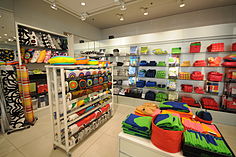- Marimekko
-
Marimekko Corporation 
Type Public (OMX: MMO1V) Industry Textiles and fashion Founded Helsinki, Finland (1951) Founder(s) Armi Ratia
Riitta ImmonenHeadquarters Helsinki, Finland Key people Mika Ihamuotila (CEO)
Maija Isola (design)
Vuokko Nurmesniemi (design)Revenue  81,107,000 € (2008)
81,107,000 € (2008)Employees 414 (2008) Website www.marimekko.com Marimekko is a Finnish company based in Helsinki that has made important contributions to fashion, especially in the 1960s and 1970s. They are particularly noted for brightly-colored printed fabrics and simple styles, used both in women's garments and in home furnishings.[1]
Contents
History
Foundation
Marimekko was founded in 1951 by Viljo and Armi Ratia, after the former's oilcloth factory project failed and was converted to a garment plant. Armi asked some artist friends to apply their graphic designs to textiles. In order to show how the fabric could be used, the company then designed and sold a line of simple dresses using their fabric. It came as an early recognition of fashion as an industrial art and of Marimekko's role in the process when Finland's leading industrial designer Timo Sarpaneva invited the company to present a fashion show (albeit canceled at short notice) at the 1957 Triennale in Milan. The garments were eventually showcased in the nearby Rinascente upscale department store under its then store display manager Giorgio Armani.[2]
Pioneering design
Two pioneering designers set the tone for Marimekko: Vuokko Nurmesniemi in the 1950s, and Maija Isola in the 1960s. [3][4] Nurmesniemi designed the simply-striped red and white Jokapoika shirt in 1956; Isola designed the iconic Unikko (poppy) print pattern in 1964. [5]
Marimekko's bold fabrics and bright, simple design strongly influenced late 20th-century taste.[6] Many of the early Marimekko designs, including Maija Isola's Unikko, remain in production today.[7]
Commercial growth
Marimekko was first introduced to the United States by the architect Benjamin C. Thompson, who featured them heavily in his Design Research stores. They were made famous in the United States by Jacqueline Kennedy, who bought eight Marimekko dresses which she wore throughout the 1960 US Presidential campaign. [8]
In the mid-1960s, Crate and Barrel began a relationship with Marimekko, which continues to this day, utilizing their designs on textiles sold in their stores. Crate and Barrel also uses Marimekko patterns as display backdrops in their stores to add color and seasonality.
By 1965, the company employed over 400, and the company was in every aspect of fine design, from fabrics to toys, dinnerware, even completely equipped small houses. That year, Armi Ratia told Pan Am's Clipper magazine that she was "against success--it is a sick word. Too many side effects." In the interview by R.E. Smallman, she also said that she did not like "hats, corsets. There is almost no more bra or even pants--no elegant woman will wear stockings, perhaps even no shoes. The world changes quickly, and this is expression of the new society."
In 1985, the company was sold to Amer-yhtymä. In the beginning of the 1990s, Marimekko was in a bad financial condition and was considered ready for bankruptcy. It was then bought from Amer by Kirsti Paakkanen, who introduced new business methods in the company and is generally seen as having saved Marimekko. [8]
Later on the 1990s Marimekko achieved publicity in the hit series Sex and the City. The fictional main character of the series, sex-and-relationship columnist Carrie Bradshaw, wore a Marimekko bikini on the season 2 and later on, a Marimekko dress. On the fifth season the series also introduced tablecloths with Marimekko prints. [8]
In 2005, Marimekko's revenue had quadrupled since Paakkanen's purchase, and its net income grown 200-fold. Kirsti Paakkanen remained CEO of Marimekko and owned 20 % of the company via her business Workidea. In 2007, Paakkanen announced she would gradually hand over her ownership to Mika Ihamuotila as CEO and biggest owner of the company.
In 2007, Marimekko began opening individually-owned Marimekko Concept Stores in the United States and Canada.
Currently there are stores located in New York, Cambridge, Massachusetts; Oxford, Mississippi; Miami, Florida; and Vancouver, British Columbia.[9] By September 2011 there were 84 stores across the world. [8]
Marimekko chart
The Marimekko name has been adopted within business and the management consultancy industry to refer to a bar chart where all the bars are of equal height, there are no spaces between the bars, and the bars are in turn each divided into segments of different height. The design of the 'marimekko' chart is said to resemble a Marimekko print.[10] The chart's design is ingenious, encoding two variables (such as percentage of sales and market share), but it is criticised for making the data hard to perceive and to compare visually. [11]
Bibliography
- Aav, Marianne. Marimekko: Fabrics, Fashion, Architecture. Yale University Press, 2003. ISBN 978-0300101836
- Cole, Drusilla. The Pattern Sourcebook: A Century of Surface Design. Laurence King, 2009. ISBN 978-1856696210
- Fogg, Marnie. 1960s Fashion Print: A Sourcebook. Batsford, 2008. ISBN 978-0713490541 (6 page-sized illustrations of Isola's prints) Google Books
- Isola, Kristina. Maija Isola: Life, Art, Marimekko. Design Museo, 2005. ISBN 978-9529878420
- Jackson, Lesley. Twentieth Century Pattern Design. Princeton Architectural Press, 2007. ISBN 978-1568987125
- Suhonen, Pekko. Phenomenon Marimekko. Marimekko Oy, 1986.
References
- ^ "Marimekko - Finnish Design". http://www.finnishdesign.com/finnish-design-companies/marimekko.
- ^ Kalin, Kaj; Sarpaneva, Timo (1986). Sarpaneva. Helsinki: Otava. ISBN 951-1-07887-9.
- ^ Kristina Isola, 2005
- ^ Marnie Fogg, 2008
- ^ Marimekko Timeline Retrieved 30 October 2011
- ^ Lesley Jackson, 2007
- ^ Marimekko Products (in 2011) Retrieved 30 October 2011
- ^ a b c d Qureshi, Huma (20 September 2011). "The Guardian House and Home Blog". Marimekko's bid for world domination. The Guardian. http://www.guardian.co.uk/lifeandstyle/house-and-homes-blog/2011/sep/20/marimekko-textile-design. Retrieved October 30, 2011.
- ^ Marimekko Shop Locator Retrieved 30 October 2011
- ^ Mekkographics.com
- ^ Example Marimekko Chart Retrieved 30 October 2011
External links
Categories:- Companies listed on the OMX exchanges
- Finnish design
- Textile design
- Fashion design
- Clothing companies
- Clothing brands
- High fashion brands
- Finnish loanwords
- Companies based in Helsinki
Wikimedia Foundation. 2010.


